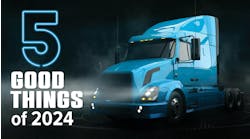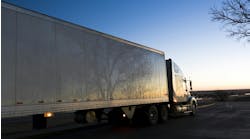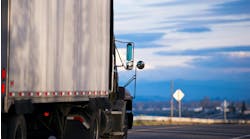Trucks are playing a critical role determining this segment's winners and losers
The future doesn't look too bright for food-industry fleets these days. Supermarket sales are estimated to rise just 2% this year, according to the Food Marketing Institute. At the same time, food manufacturers are watching their profit margins shrink, falling to just 3% last year. And, according to Fortune magazine, stockholders are none too pleased, either, as returns on their investments over the last two decades have dropped to 2% from a high of 15% in 1978.
What's happening? Competition is driving down prices, consumer tastes and shopping patterns are changing, technology is making traditional business methods obsolete, and there are way too many grocery stores, said Richard H. Kochersperger, director of the Center for Food Marketing at St. Joseph's University in Philadelphia.
What does that mean for food distribution fleets? Kochersperger's annual Transportation & Fleet Maintenance Report showed that lowering the cost of transportation is the main goal of this industry segment.
In 1999, transportation costs went down in almost all operating categories, with food distributors gaining efficiencies in their delivery operations by partnering with retailers to reduce unnecessary stops and waiting time, while offering incentives for higher performance levels, Kocherspergersaid.
"In the future, food industry executive efforts will continue to focus on squeezing out unnecessary costs in all aspects of their operations," he said. "A 'lean and mean' atmosphere has been introduced into many food distributor operations, and this new business philosophy continues to put pressure on the transportation department to reduce costs and become more efficient."
Fleet with Spunk Famed cookie and muffin maker Otis Spunkmeyer is one food distributor looking to gain more efficiency - and more overall profitability - by reworking its fleet operation.
A $200-million California-based company, Otis Spunkmeyer used to bake and sell its products in shopping malls around the country. When rising rents began eating into the company's profits, its approach to business changed.
Otis Spunkmeyer began to sell its products direct to restaurants, grocery stores, and convenience stores nationwide. From three plants in California, Pennsylvania, and South Carolina, the 33-year-old company bakes and flash-freezes its goods, transports them to a network of 58 sales centers, then distributes them to its customers via Direct Store Delivery vehicles.
Otis Spunkmeyer operates some 528 refrigerated units, from medium-duty delivery vehicles to Class 8 tractor-trailers.
As getting more efficiency and productivity out of its fleet continued to prove elusive, operations manager Rick Pruneau decided to make some changes about 10 years ago.
"Fleet management was not one of our strong suits, so we decided to look at outsourcing not only some of our vehicles, but maintenance and management responsibilities as well," he explained at a recent food and beverage industry conference sponsored by Ryder Transportation Services.
"We needed new truck specifications. Many of our route-sales drivers worked out of their homes and had to come in to restock their vehicles two or three times a week," he said. "We wanted a larger vehicle that would enable them to hold an entire week's inventory."
Otis Spunkmeyer contracted with Ryder to revamp its equipment, provide day-to-day fleet management, and look at contract carriage options to control delivery costs for goods from its bakeries to some of its more remote sales centers.
According to Pruneau, many of the changes - especially those involving financing vehicle acquisitions - were possible because there was a higher level of executive involvement in the fleet arena, which hadn't occurred in the past.
"We put a good lease package together with Ryder and our bank because our CFO was involved," he said. "Five or ten years ago, we couldn't have done that."
Pruneau also said that Otis Spunkmeyer's primary goal in outsourcing parts of its fleet operations is not only to save money and gain greater efficiency, but to allow the company to focus on core business functions.
"Ryder takes on some of my fleet-manager duties, which allows me to focus on such things as supply-chain opportunities and the new products we're putting on the market," Pruneau said. "I can look at ways to get frozen goods to our sales centers more frequently from our three plants without having to send our trucks halfway across the country."
New kids on the block Even as traditional food distributors try to reconfigure themselves to succeed in today's rough-and-tumble food industry, new challengers are entering the market and rewriting the entire game plan of how food is delivered to consumers.
These are the Internet grocers - companies that eschew the use of retail food stores altogether and instead deliver food to consumers directly from the warehouse to their front door.
That direct-delivery logistics model is completely redefining the role of trucks and drivers in the food business - taking them out from behind the docks of grocery stores and warehouses and putting them right at the customer's front door.
According to Mike Smith, director of distribution for Homegrocer.com, this means radical changes to truck specs. "We're spending a majority of our time in residential neighborhoods, with lots of little children around, so line-of-sight from the truck cab is crucial.
"And tight delivery zones with lots of narrow streets in areas such as San Francisco and Boston present another set of challenges. At the same time, we still need power and a heavy-duty chassis. San Francisco, for instance, has 20-degree hills; if we downsize to a smaller chassis, our components won't be as strong and we may get shorter vehicle life. That's unacceptable."
Image is also far more crucial to direct-to-customer delivery operations, Smith said. "We did a survey last summer and discovered that 20% of our customers tried us because they saw our truck," he said "The trucks are moving billboards for us, so we wash them five times a day. We need a clean, pristine truck."
Seattle-based Homegrocer.com uses FL 60 Business Class Freightliner chassis to make 30 deliveries before restocking. The truck's cargo hold is divided into three separate temperature zones. Cold-plate technology keeps the freezer zone down between -10 and 0 deg. F, while the chill zone stays between 35 and 40 deg. F. A heater in the ambient zone keeps the temperature steady for fresh produce for deliveries during winter, said Smith.
Homegrocer.com hopes to add 1,000 to 1,200 vehicles to its fleet this year as it expands to between 15 and 20 new "sites." Those sites represent new metropolitan markets outside the West Coast base the company has operated from since 1997. Each will require trucks, a distribution center, and 300 employees.
It's an ambitious expansion program, but one Homegrocer.com believes it can easily achieve. As Kochersperger said in his report, the food industry's roots include home delivery of groceries.
"Many think home delivery of groceries won't work, but in 1929, 15% of food products were delivered directly to the home," he said. "The business models have been there; it's just a little different with Internet technology."
Internet grocery trucks, however, also need to be more driver-friendly than traditional equipment in food distribution fleets.
That's why Homegrocer.com's trucks are equipped with automatic transmissions, door hangers to store company literature for new customers, and a workstation where drivers can stash plates of cookies for children and dog biscuits to assuage the doubts of overly protective canines, said Smith.
Those needs also highlight the unique demands Homegrocer.com places on its drivers.
"We're literally going into someone's home to deliver the groceries," Smith said. "When we stop out on the street, we hand out cookies for the kids. We're interacting with consumers in a completely different way from grocery stores.
"We need driver-salesmen who understand our customer service objective," he added. "This is not the typical Class 8 commercial driver position at all. We look at personality first. We're looking for self-starters who have integrity, honesty, and personal pride. Those are the things we can't teach."
But taking the grocery business online doesn't mean cost is no longer an issue. "We need to control costs. Working with groceries means working with small margins, so we really need to watch our nickels and dimes," said Smith. "If we can spec our equipment effectively and keep maintenance costs down, our fleet becomes a much more effective tool."


